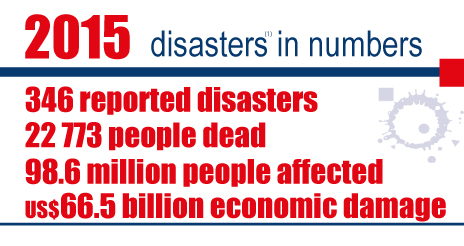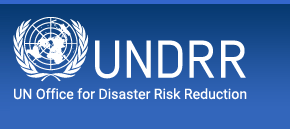- Our Mandate
- Mission and Objectives
- UNDRR in the UN
- Work Programme & Annual Reports
- Results Based System
- Work Partnerships
- Headquarters - Geneva
- SG-UN representatives for DRR
- Regional Office – The Americas and the Caribbean
- Head of the Regional Office – The Americas and the Caribbean
- What is Disaster Risk Reduction?
- What is the International Strategy?
- History of UNDRR
THE HUMAN COST OF THE HOTTEST YEAR ON RECORD - CLIMATE CHANGE AND EL NINO DROVE DISASTERS WORLDWIDE IN 2015
Press release
February 11, 2016– UNDRR 2016/05

By: UNDRR The Americas.
11 February 2016, GENEVA – The hottest year on record, 2015, has confirmed that weather and climate-related disasters now dominate disaster trends linked to natural hazards, according to a new analysis presented today.
The top five most disaster-hit countries in 2015 were China (26), USA (22), India (19), Philippines (15) and Indonesia (11).
The head of the UN Office for Disaster Risk Reduction, Robert Glasser, said: “We have come through the hottest year on record. 98.6 million people were affected by disasters last year and climate often aided by a strong El Niño was a factor in 92% of those events. The most obvious impact was the 32 major droughts recorded which was more than double the ten-year annual average. These affected 50.5 million people and many have continued into this year particularly in Africa.
“The main message from this trends analysis is that reducing greenhouse gases and adapting to climate change is vital for countries seeking to reduce disaster risk now and in the future.”
Mr. Glasser also commented: “The Nepal earthquake has confirmed yet again that earthquakes are the most deadly natural hazard category and underlines the importance of ensuring compliance with building codes. It is buildings which kill people in seismic zones as we saw again at the weekend in Taiwan.
“National disaster management agencies in Asia are doing good work in reducing death tolls from storms through early warnings and timely evacuations, especially in the Philippines, China, Japan and the small island states of the Pacific. Asia and the Pacific bore the brunt of the 90 storms reported last year which included 48 cyclone-strength storms.”
There were 996 fatalities in recorded storms last year, compared to an annual average of 17,778 from 2005 to 2014, according to preliminary data from the Centre for Research on the Epidemiology of Disasters (CRED), Belgium, which shows that the death toll from 346 major reported disasters last year was 22,773 – including 8,831 deaths from the Nepal earthquake.
CRED Director, Dr. Debarati Guha-Sapir, said: “At 22,773 deaths for 2015, overall disaster mortality was considerably down on the ten-year average of 76,424 deaths. It does seem that early warnings are having an impact in the case of storms. Further investment in this area is warranted by these numbers.
“Extreme temperatures, mostly heatwaves have been severe in 2015. Several countries in Europe faced heat stress with significant numbers of deaths particularly in France. India and Pakistan suffered from some of the most severe heat waves in recent times. Mortality from extreme temperatures are very under-estimated and need better evaluation of their impact.
2015 DISASTER FACTS AND FIGURES vs 2005-2014 AVERAGES
There were 32 major droughts recorded last year compared to an annual average of 15 over the previous decade. Droughts affected 50.5 million people, well above the ten year average of 35.4 million.
Floods have traditionally affected the most people in any given year but were in second place last year when 152 floods affected 27.5 million people and claimed 3,310 lives. This compares with the ten year average of 5,938 deaths and 85.1 million people affected. Floods in India last year affected 16.4 million people.
Rising sea levels and sea surface temperatures were factors in a very active cyclone season in Asia and the Pacific which saw 37 cyclones and typhoons. Globally, there were 90 reported storms resulting in 996 deaths and affecting 10.6 million people. This compares with a ten year average of 17,778 deaths and 34.9 million people affected.
2015 was the hottest year on record and this contributed to a major loss of life from heatwaves, including a combined total of 7346 deaths: in France (3,275), India (2,248) and Pakistan (1,229). Overall, 7,346 deaths were recorded and 1.2 million people were affected by extreme temperatures in 2015. This compares with the ten year average of 7,232 deaths and 8.7 million affected.
Other statistics from 2015: earthquakes and tsunamis, killed 9,525 people (including Nepal) and affected 7.2 million people; landslides triggered by heavy rains, killed 1,369 people and affected 50,332; wildfires took 66 lives and affected almost 495,000 people.
Related links
Download the PDF version of this press release
Infographic on disaster trends in 2015
About UNDRR: UNDRR is the UN office dedicated to disaster risk reduction. It is led by the Special Representative of the Secretary General for Disaster Risk Reduction and supports implementation of the Hyogo Framework for Action 2005-2015: Building the Resilience of Nations and Communities to Disasters which seeks “the substantial reduction of disaster losses, in lives and in the social, economic and environmental assets of communities and countries.”
Follow the UNDRR news online:
 Now we have twitter account @UNDRR Américas y el Caribe
Now we have twitter account @UNDRR Américas y el Caribe
JOIN US!
Tweets por el @UNDRR Américas y el Caribe
